Discover 10 hidden attractions, cool sights, and unusual things to do in Arecibo (Puerto Rico). Don't miss out on these must-see attractions: Arecibo Observatory, Arecibo Light, and Arecibo Telescope. Also, be sure to include Catedral de San Felipe Apóstol in your itinerary.
Below, you can find the list of the most amazing places you should visit in Arecibo (Arecibo).
Table of Contents
Arecibo Observatory
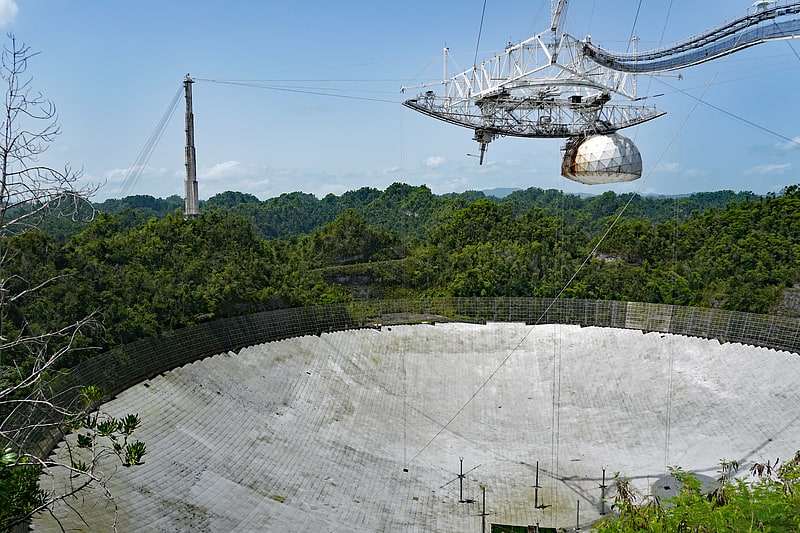
Observatory in Arecibo, Puerto Rico. The Arecibo Observatory, also known as the National Astronomy and Ionosphere Center and formerly known as the Arecibo Ionosphere Observatory, is an observatory in Barrio Esperanza, Arecibo, Puerto Rico owned by the US National Science Foundation.
The observatory's main instrument was the Arecibo Telescope, a 305 m (1,000 ft) spherical reflector dish built into a natural sinkhole, with a cable-mount steerable receiver and several radar transmitters for emitting signals mounted 150 m (492 ft) above the dish. Completed in 1963, it was the world's largest single-aperture telescope for 53 years, surpassed in July 2016 by the Five-hundred-meter Aperture Spherical Telescope (FAST) in China. Following two breaks in cables supporting the receiver platform in mid-2020, the NSF decommissioned the telescope. A partial collapse of the telescope occurred on December 1, 2020, before controlled demolition could be conducted. The remains of the telescope are being removed as NASA evaluates plans for a replacement instrument.
The observatory also includes a smaller radio telescope, a LIDAR facility, and a visitor center, which remain operational after the telescope's collapse.[1]
Address: 53995 Caja, 00612 Arecibo
Arecibo Light
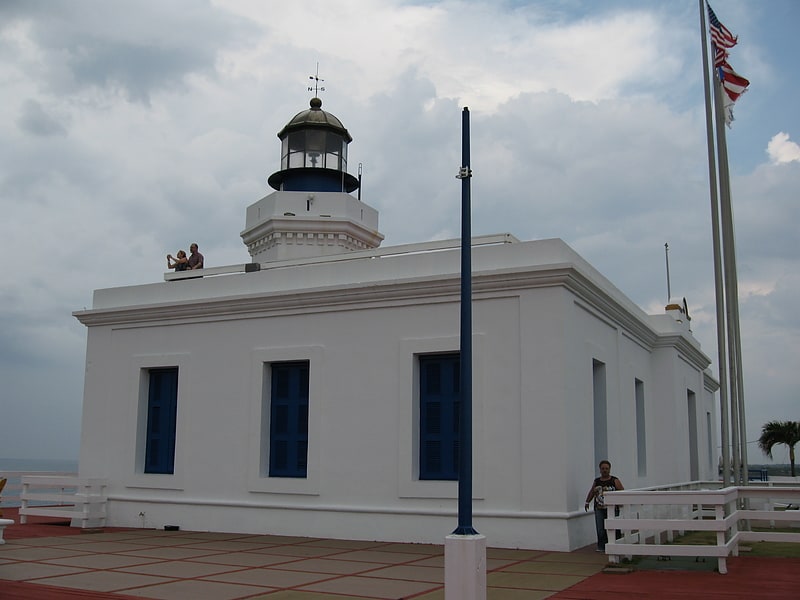
Lighthouse in Arecibo, Puerto Rico. Arecibo Light is a historic lighthouse located in the city of Arecibo, Puerto Rico. It is also known as Los Morrillos Lighthouse because of its location on top of a rocky headland known as Punta Morrillos. The lighthouse was constructed and was lit in 1898. This was the last lighthouse built by the Spanish government on the island.
The style of construction is neoclassical with a rectangular shape of 40 feet 4 inches (12.29 m) wide by 84 feet 2 inches (25.65 m) long, and has attached a hexagonal tower covered by a bronze dome with a working lantern. The original lens was a third-order Fresnel, with an 18-mile (29 km) radius. The lighthouse was converted to electric power in 1931. Currently, it has a 190 mm lens with a white flash every five seconds.
After the light was automated in 1964, the unmanned structure fell victim to decay and vandalism. The Fresnel lens was damaged in 1975 and destroyed in 1977.
A private company completed the restoration of the lighthouse in 2001. It has been operated as a foundation until the present. The lighthouse is called the Arecibo Lighthouse and Historical Park that includes a replica of a Taino Indian Village, a replica of the Niña, Pinta and Santa Maria, a Slavery Quarters, a replica of a Pirate Ship, a Pirate Cave, a Mini Zoo, various Salt Water Aquariums, a Playground, and a Water Park. The lighthouse is home to a small museum showcasing marine artifacts, the history of the lighthouse, and the Spanish–American War.
This lighthouse should not be confused with the Cabo Rojo lighthouse, known as Faro de Los Morrillos de Cabo Rojo.[2]
Address: Carr 655 Bo., Arecibo
Arecibo Telescope
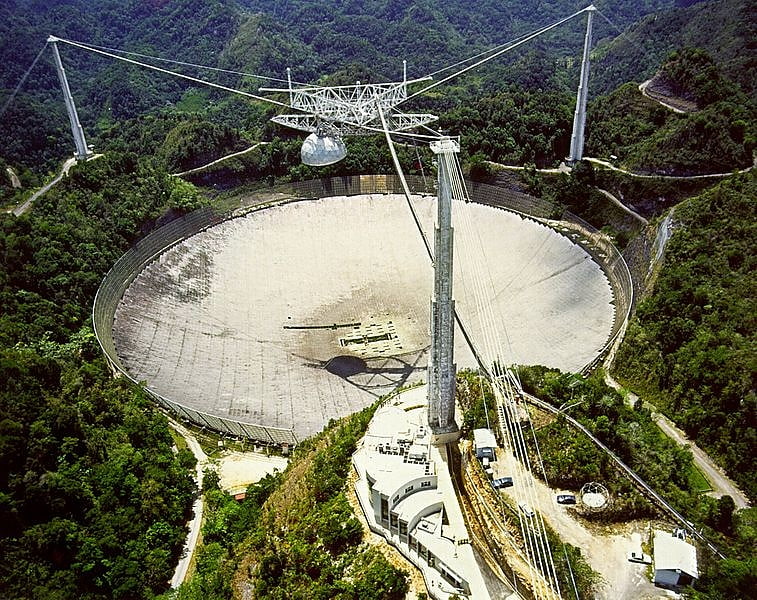
The Arecibo Telescope was a 305 m spherical reflector radio telescope built into a natural sinkhole at the Arecibo Observatory located near Arecibo, Puerto Rico. A cable-mount steerable receiver and several radar transmitters for emitting signals were mounted 150 m above the dish. Completed in November 1963, the Arecibo Telescope was the world's largest single-aperture telescope for 53 years, until it was surpassed in July 2016 by the Five-hundred-meter Aperture Spherical Telescope in Guizhou, China.
The Arecibo Telescope was primarily used for research in radio astronomy, atmospheric science, and radar astronomy, as well as for programs that search for extraterrestrial intelligence (SETI). Scientists wanting to use the observatory submitted proposals that were evaluated by independent scientific referees. NASA also used the telescope for near-Earth object detection programs. The observatory, funded primarily by the National Science Foundation (NSF) with partial support from NASA, was managed by Cornell University from its completion in 1963 until 2011, after which it was transferred to a partnership led by SRI International. In 2018, a consortium led by the University of Central Florida assumed operation of the facility.
The telescope's unique and futuristic design led to several appearances in film, gaming and television productions, such as for the climactic fight scene in the James Bond film GoldenEye (1995). It is one of the 116 pictures included in the Voyager Golden Record. It has been listed on the US National Register of Historic Places since 2008. The center was named an IEEE Milestone in 2001.
Since 2006, the NSF has reduced its funding commitment to the observatory, leading academics to push for additional funding support to continue its programs. The telescope was damaged by Hurricane Maria in 2017 and was affected by earthquakes in 2019 and 2020. Two cable breaks, one in August 2020 and a second in November 2020, threatened the structural integrity of the support structure for the suspended platform and damaged the dish. Due to uncertainty over the remaining strength of the other cables supporting the suspended structure, and the risk of collapse owing to further failures making repairs dangerous, the NSF announced on November 19, 2020, that the telescope would be decommissioned and dismantled, with the radio telescope and LIDAR facility remaining operational. Before it could be decommissioned, several of the remaining support cables suffered a critical failure and the support structure, antenna, and dome assembly all fell into the dish at 7:55 a.m. local time on December 1, 2020, destroying the telescope.[3]
Catedral de San Felipe Apóstol
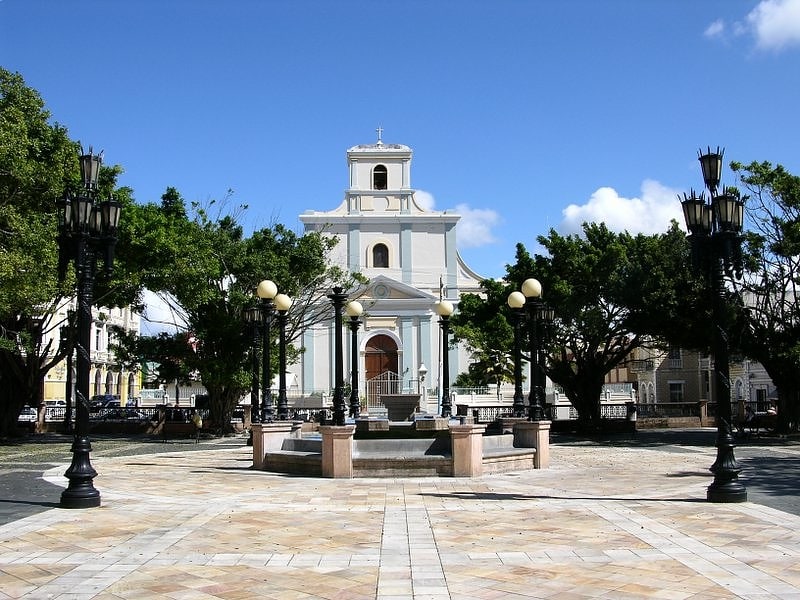
Cathedral in Arecibo, Puerto Rico. The Catedral de San Felipe Apóstol, or in English, Cathedral of St. Philip the Apostle, is a Catholic cathedral located in Arecibo, Puerto Rico. It is the seat of the Diocese of Arecibo.[4]
Address: Calle Gonzalo Marin, 00612 Arecibo
Palacio del Marqués de las Claras

Palacio del Marqués de las Claras or Casino de Arecibo, as it is also known, was built in 1888 by Fernando Fernández Umpierre, Marqués de las Claras. At the end of the 19th century, the Marqués de las Claras distinguished himself as one of the most prominent and wealthy owners of sugar estates in Puerto Rico. He was known for his sponsorship of the arts and cultural events.
After the death of the Marqués in 1896, the palace, located in Arecibo barrio-pueblo, became the meeting place of the aristocratic elite of Arecibo. It was the meeting place for the conservative politicians of Puerto Rico, a place to discuss the politics related to the finance and government administration during the Spanish colonial period in Puerto Rico. Currently, the palace is a venue for important social activities. It was listed on the National Register of Historic Places in 1988.
The neoclassical design of the facade makes use of ornamentation to differentiate the piano nobile (the principal floor) of the palace from the first floor. The second level is elegant and refined. The asymmetric entry stands out slightly with ornamental detail.[5]
Corregimiento Plaza Theater
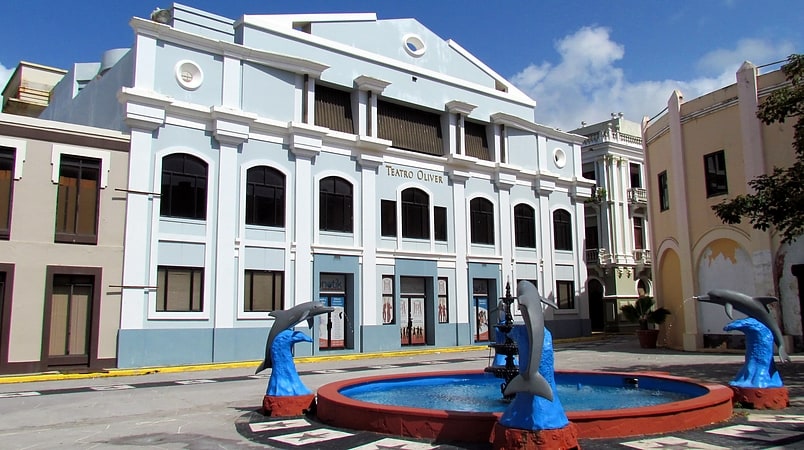
Theater in Arecibo, Puerto Rico. The Corregimiento Plaza Theater in Arecibo, Puerto Rico was built in 1876 as a three-story brick Classical Revival theater building known as Teatro Oliver or the Oliver Theater. It was listed on the National Register of Historic Places on January 6, 1986. It was built with a mechanism that could raise and lower the orchestra floor so that the space could be used for different purposes. It was remodelled in 1919 after a series of earthquakes damaged it, and it was remodelled again in the 1930s. The floor moving mechanism was then removed, the stage was shortened, and balconies were replaced by a new mezzanine. In 1955 it became exclusively a movie house, with a cinemascope screen. It operated as a movie house until 1984 when it was closed.[6]
Paseo Víctor Rojas
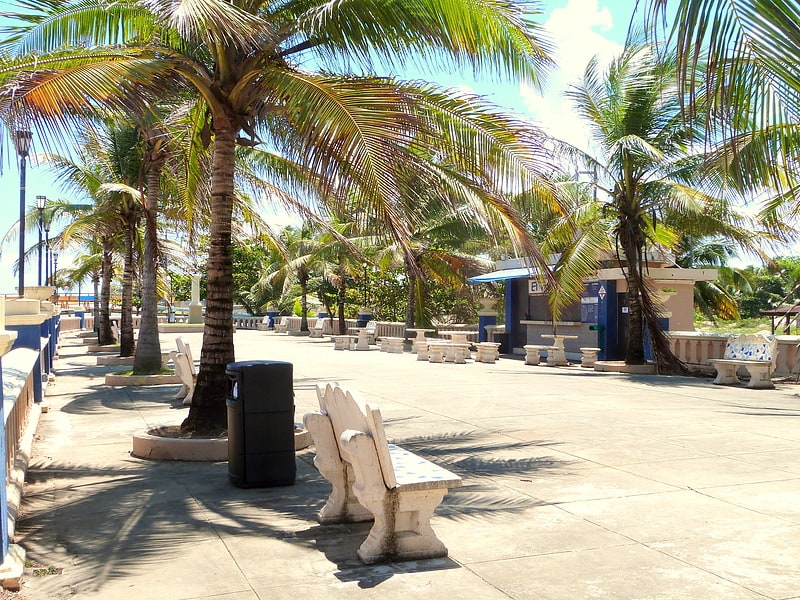
Paseo Víctor Rojas, also known as El Fuerte or Paseo de Damas, in Arecibo, Puerto Rico, was built in 1881. It was listed on the National Register of Historic Places in 1986.
It is a rectangular promenade that was built over the ruins of San Miguel Fort, in part using stone from the ruins.
The original paseo was damaged in the Hurricane of San Ciriaco in 1899.
It is unique as a place constructed for the "Isabellan", i.e. equivalent to "Victorian" pastime of promenading. It acquired the name "Victor Rojas" for the location of a memorial to this person, a fisherman, who undertook rescues starting from near this location, to save persons from boats foundering.[7]
Gonzalo Marín 101
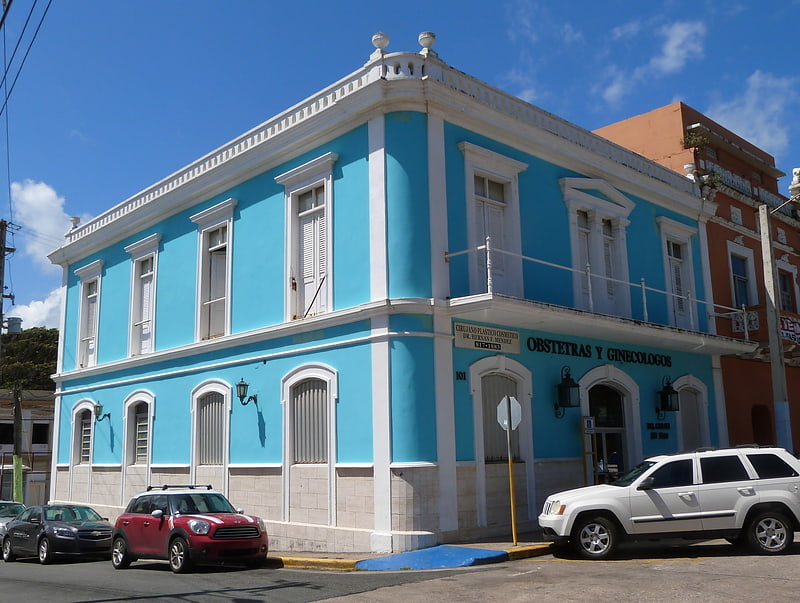
Gonzalo Marín 101 or Citibank located in Arecibo, Puerto Rico is an occupied, private building used for commercial purposes which was listed on the US National Register of Historic Places on November 19, 1986.
The structure located at Calle Gonzalo Marín 101, on the southeast corner of Calle Hostos de Arecibo in Arecibo barrio-pueblo, was built in 1908 to house banking institutions. For most of its history, the structure was occupied by the most important banking institutions in Arecibo.
In the 1930s, First National City Bank, the first American bank in the northwest region of Puerto Rico opened its branch in this building. The bank quickly gained importance as it became the financial center of the North American sugar estates in the Arecibo region. Banks in Puerto Rico helped keep sugar as the main line of the economy through direct financing of the sugarcane industry until 1950.
This building represents the transition between the Spanish Neoclassical period and the new Baroque architectural movement that was already widespread in the United States for the first decade of the 20th century. The use of the pediment and the decorative moldings around the doors contrast sharply with the austerity representative of the Spanish Neoclassical period. This structure is the only example of the transition period between one style and another in Puerto Rico.[8]
Casa de la Diosa Mita
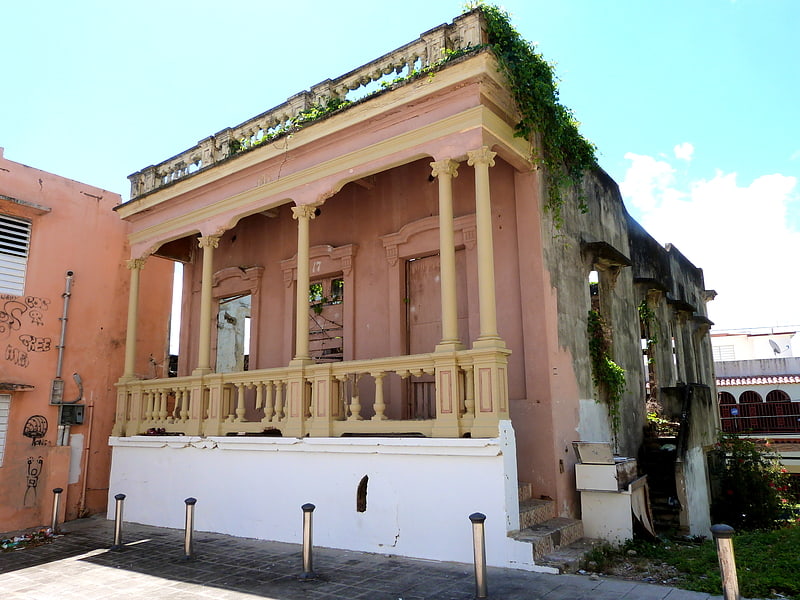
The Casa de la Diosa Mita was a house located in Arecibo barrio-pueblo in Arecibo, Puerto Rico. The house itself is unique because of its Beaux-Arts architectural design, and was listed on the National Register of Historic Places on September 9, 1988.
The NRHP registration form states that in the future the NRHP record should be updated to reflect its significance because of who lived there. A self-professed goddess lived there. When she was living in this house in 1940, Juanita "Mita" García Peraza declared herself to be God and began the Mita Congregation, which continues to this day with its headquarters in Puerto Rico and chapters in the United States, Canada, Venezuela, Colombia, Ecuador, Panama, Costa Rica, Mexico, El Salvador, Spain and the Dominican Republic.
By 2017 the house was in ruins and what remains is a shell of the structure.[9]
Edificio Oliver
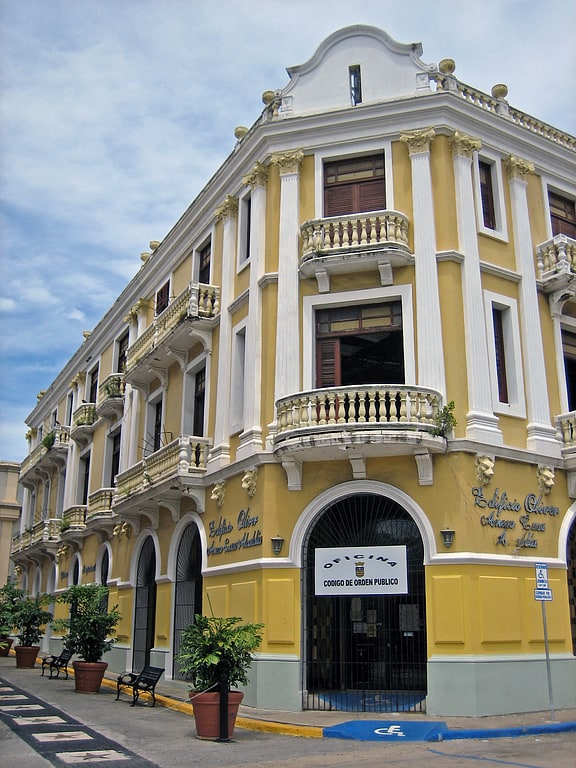
Building in Arecibo, Puerto Rico. Edificio Oliver in Arecibo, Puerto Rico was built in 1914. The building houses government offices for the municipality of Arecibo.
A Beaux Arts-style building, it was the first building made of reinforced concrete in the Arecibo area.
It is located in the town center on the location of the former "King's House", the military garrison building built by the Spanish government in 1765. After 1868 that building became a courthouse, a police headquarters, and a public school then was demolished in 1913. The Edificio Oliver was built soon after in the corner location and was used both as a residence and for commercial purposes. It served also served as a foreign consulate.
Edificio Oliver was listed on the National Register of Historic Places in 1986.[10]